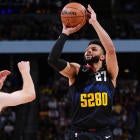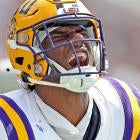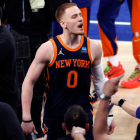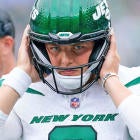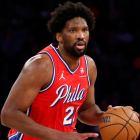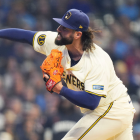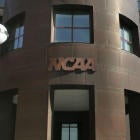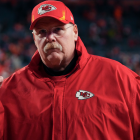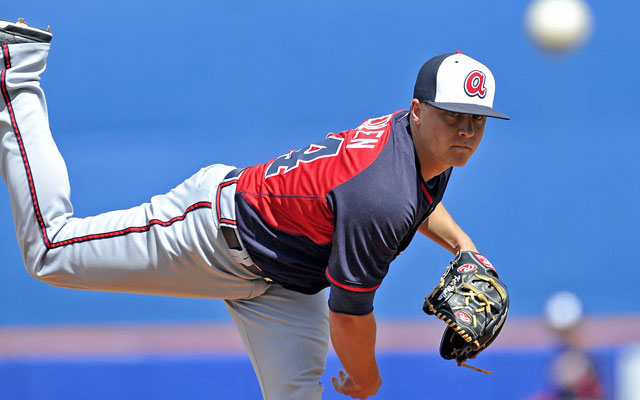
More MLB: Power Rankings | Expert Picks | Latest news & notes | Fantasy news
Baseball's hottest performance-enhancing treatment can't be injected, snorted or swallowed. It's delivered by a man in a mask, holding a knife, and pitchers everywhere want it. James Andrews is one of the men in the mask, one of the men with the knife, and he's not happy about baseball's latest craving.
Pitchers are jonesing for Tommy John surgery.
In an oblique way this is Andrews' fault, because he's so good at his job. His job? He's a surgeon, one of the most famous surgeons in America -- lots of you knew who he was in the first paragraph, even without the title Dr. -- and his patients climb off the operating table and go to the All-Star Game.
It's not that easy, of course, but pitchers -- especially the young ones, pushed into Dr. Andrews' office by their parents -- don't understand. They read about Stephen Strasburg having Tommy John surgery in 2010 and striking out 10.4 batters per nine innings ever since. Cardinals ace Adam Wainwright had it in 2011, signed a nearly $100 million extension in 2013 and finished second in the Cy Young voting. Tigers closer Joe Nathan had the surgery in 2010, was an All-Star in 2012 and was at his most dominant in 2013, at age 38 for the Rangers, when he set career-bests with 5.0 hits allowed per nine innings and a 0.897 WHIP.
Young pitchers know those stories. So do major-leaguers. So they show up at Dr. Andrews' office in Birmingham, complaining of a sore elbow, wanting to undergo the procedure. Today, preferably.
"The ones we have the most trouble with are high school players, sophomores and juniors," Dr. Andrews says. "They're worried about their career and going to college, or worried about getting drafted out of high school, and their parents are pushing. I could take a kid like that and have him ready for surgery in 15 or 20 minutes."
But he doesn't. Because James Andrews knows what young pitchers don't: Tommy John isn't foolproof. Holes are drilled into the bones of the pitcher's upper and lower arm, and a tendon -- usually from the pitcher's arm or a leg -- is snaked through those holes in a figure-eight pattern to stabilize the elbow. It's not a simple procedure, but Andrews knows there are wonderful examples out there, like Nationals starter Jordan Zimmermann, who had the surgery in 2009 and became one of baseball's best starters in 2013. And like Billy Wagner, who had the surgery in 2008 at age 37, and in 2010 had a career-best 1.43 ERA with 104 strikeouts and just 38 hits allowed in 69 1/3 innings.
Andrews tells young pitchers about the complications. The nerve goes out. A piece of the bone breaks off where the tunnels have been drilled. The ulnar collateral ligament re-tears. Or just pain, unexplained pain, that keeps a pitcher from pitching. The surgery went well, the MRI looks good, but the arm hurts. No explanation. And Andrews says that happens to 5 percent of Tommy John patients.
"Particularly to young kids," he says.
Andrews tries to tell the young pitchers, and their parents. And they don't want to hear it.
"They almost get mad at you," he says. "They think the surgery is better than ever, and it's just not true."
Take a second and understand what you just heard. You're hearing a surgeon, maybe the best in his field, arguing against the surgery he has nearly perfected. I hear this and ask Dr. Andrews if he's seen the movie Malice. Alec Baldwin plays the role of an egomaniacal surgeon and he goes over the top with it, nearly to the point of unintentional satire, when he unleashes his "I am God" rant. Andrews says he hasn't seen the movie and then cuts me off, laughing, when I describe the "I am God" rant.
"No, hell no," he says. "You never think that. Don't ever think that. You can be blown away, man, don't ever think that. My rule is, the only results I ever remember are the bad ones. And believe me, everybody has bad results. You've got to dwell on the bad ones. You go around blowing yourself up -- this athlete made the World Series, this one did this, that or the other -- and you're not improving your capabilities. You study the ones that didn't do so well. That's what makes you better."
High school kids don't want to hear that. Neither do their parents. Hell, neither do the major-leaguers who come to Andrews, or their version of parents -- their agents. Andrews says he has to talk big-leaguers, and their agents, off the Tommy John ledge all the time. I asked him how many of the pitchers who come to his office with arm pain announce that they want Tommy John surgery, and he says a crazy number. Then he corrects himself and says an even crazier number.
"At least 50 percent of the time," he says. "No, maybe closer to 60 percent of the time."
The big-leaguers are more inclined to be talked into conservative treatment -- rest, rehabilitation. It's the high school kids and their parents who want the magic Tommy John pill that worked so well for Adam Wainwright, and therefore will work well for Little Johnny. Andrews tells them the secret to Tommy John surgery isn't the surgery.
It's the rehabilitation.
"The rehab has been polished so much better," he says. "We have a better grasp of the timelines now, and we've accelerated the rehab. We used to put them in a splint and not move much for six weeks. Now they're moving in five days. With all the things they do in rehab -- throwing programs, core strength, lower body -- these guys come back as much better athletes with better bodies, better flexibility. If they're throwing harder it's because of the rehab, not the surgery."
Some athletes need the surgery, no question about it. The elbow ligament snaps or is on the precipice. More pitchers than ever require the surgery, and Andrews blames it on year-round pitching in youth baseball, which I wrote about in 2010. Pitching is a violent, unnatural motion that requires months of rest, but youth baseball is played all year, especially in warmer states like California, Florida and Texas. Their elbow ligaments fray -- every pitcher has frayed ligaments -- but they never rest enough to heal. A healed ligament is a stronger ligament. One that never heals? It's a ticking time bomb.
More than ever, pitchers arrive in the big leagues with a time bomb in their elbow. Seventeen big-league pitchers have undergone Tommy John surgery since spring training, an unprecedented rate, but the most common patients who visit Dr. Andrews are high school kids. And their parents. Seeking the magic elixir of Tommy John surgery.
For the pitchers young and old who have elbow soreness and frayed ligaments but not the snapped (or soon-to-snap) ligament, Dr. Andrews encourages rehab. He talks about rest and core strength and flexibility.
And if that doesn't work, Andrews plays the only card he has left.
"Listen," Andrews has told many pitchers (and their parents), "you can find a lot of people to operate on you -- and if so, God bless you. But I'm not the guy. If you want that, go somewhere else."
And does that work? You'd be surprised.
"Once you tell them that, they usually understand," he says. "It's a little easier for me to talk to them than if I was a young doctor that didn't have any background with this procedure. I've done this a lot, and they know that."
A lot? This happened a few years ago: Andrews was visiting a big-league camp, giving its pitchers an exam, when a 15-year veteran walked in and said, "Dr. Andrews, you don't remember me, do you? You operated on me in 1995."
The pitcher showed him the elbow.
"Yeah," Dr. Andrews says now, "I could see my scar."












